偶然みたいなこと Torn Between Two Lovers (2) [ひまつぶし]
"Torn Between Two Lovers" であらためて検索をかけていたら、オーストラリアの新聞記事 "Torn Between Two Lovers" が出たのですけど、そのサイトにウォルター・クレインの絵を入れた art.com の広告が嵌っているのでした。
これは偶然なのかしら、それとも morichan の父の跡を追いかけてくるWEB の罠なのかしら。
"Torn between two lovers - Film - Entertainment - smh.com.au <http://www.smh.com.au/news/film/torn-between-two-lovers/2008/08/08/1218139042053.html> [The Sydney Morning Herald, August 9, 2008]
2008年の映画 The Edge of Love の記事なのでした。いまのところ下手に映画について語る気力がないので股合う暇で。でもキーラ・ナイトリーは好きです、実は。
恋人ふたりの間で股割き Torn Between Two Lovers [歌・詩 ]
ふたつ前の記事で、ウォルター・クレインが挿絵を書いたギリシア神話の物語の著者の名前がメアリー・マグレガーといいました。アレッ? メアリー・マグレガーって・・・・・・と思ったひとは自分を入れて1・2名でしょうけれど、はい、1976年暮れのデビュー曲 "Torn Between Two Lovers" が翌1977年にビルボード誌で1位に輝くヒットとなった、アメリカの女性シンガーです。
つぎの記事に恋多き(複雑な相愛関係の)ラファエロ前派のひとびとを書いたのもあって、なんとなく書き留めておきたくなりました。
Mary MacGregor はミネソタ州セントポールに1948年に生まれています(St. Paul, Minnesota というと作家のフィッツジェラルドの生まれた都市です)。十代でバンドを組み、ミネソタ大学卒業後にPP&M (Peter, Paul and Mary) のメンバーだった Peter Yarrow に認められ、バックコーラスに参加、そしてピーター・ヤーローの作詞・プロデュースで歌われたのがこの曲でした(邦題はなぜか「過ぎし日の想い出」)。
もともとは『ドクトル・ジバゴ』にヤーローが触発されて、ふたりの女性への恋心に引き裂かれる野郎の(男の)歌として作詞したのだそうだけれど、メアリーさんに歌わせるということで女歌にしたのだそうです。
ロセッティのプロセルピーナ (1) Dante Gabriel Rossetti's Proserpine [Marginalia 余白に]
日本語で「ラファエロ前派」と呼ばれているグループがどこまでカバーする言葉かは諸説あるかもしれませんけれど、ウォルター・クレイン Walter Crane (1845-1915) はもちろん Pre-Raphaelite Brotherhood: PRB という兄弟団の一員であったわけではなく、活動は重なっているけれど、世代的にもちょっとあとのひとです。
John Everett Millais (1829-96)
William Holman Hunt (1827-1910)
Dante Gabriel Rossetti (1828-82)
以上が出発の3人 (1848)
William Michael Rossetti (1829-1919)
Thomas Woolner (1825-92)
James Collinson (1825-81)
Frederic George Stephens (1828-1907)
以上で最初の7人兄弟 (1848)
初期にも共鳴して兄弟団にかかわる画家たちはいろいろいるのだけれど、後期の、といってもどこまでかも諸説あるので、とりあえず兄のロセッティ後期の、中世趣味から唯美主義的なところへむかうところで密接にかかわってくるのがつぎのふたりです。――
Edward Burne-Jones (1833-98)
William Morris (1834-96)
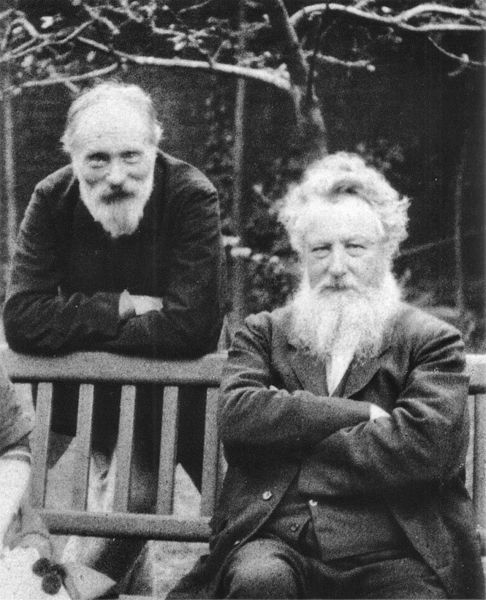
Edward Burne-Jones and William Morris (1890) image via "William Morris," Wikipedia
そして、さらに唯美主義に社会主義を加えて進んでいくウィリアム・モリスと共鳴してアーツ・アンド・クラフツ運動を一緒にやっていくのがウォルター・クレインでした。たぶん。――
Walter Crane (1845-1915)
そして、ついでながら、そっちの方向性はラファエロ前派の運動のはじめから先達で後援者であったジョン・ラスキンによって示されていたのかもしれません。――
John Ruskin (1819-1900)
ラスキンの奥さんだったEffie Gray (1828-97) と、ラスキンが一番親しかったジョン・エヴァレット・ミレーのふたりは、エフィーがラスキンと離婚した翌年の1855年に結婚しました。ラスキンとエフィーの結婚は不幸なものだったということになっていますが、彼女はミレーのモデルをつとめたりもして、惹かれていたのでした。ミレーの有名なオフィーリアの絵 (1852) のモデルになったElizabeth Siddal (1829-62) と結婚したのがロセッティでしたが、彼らの結婚も不幸なものでした。エリザベス・シッダルはロセッティのモデルとして1853年ごろから数多くの絵に描かれ、長い婚約期間を経て1860年に結婚します。しかし婚約中の1857年に知り合ってロセッティが強く惹かれていくのが Jane Burden (1839-1914) で、でも彼は婚約中だし、ウィリアム・モリスと1859年に結婚してしまいます(ジェーン・モリスになる)。エリザベスはもともと帽子屋の店員で労働者階級のひと。自らも絵筆を執って画家活動を行ない、詩も書き、ラスキンに支持もされますが、ロセッティの家の側からの蔑視や夫の浮気な性格や流産の不幸もあって、薬のアヘンチンキを多用して結婚2年後の1862年に亡くなってしまいます。
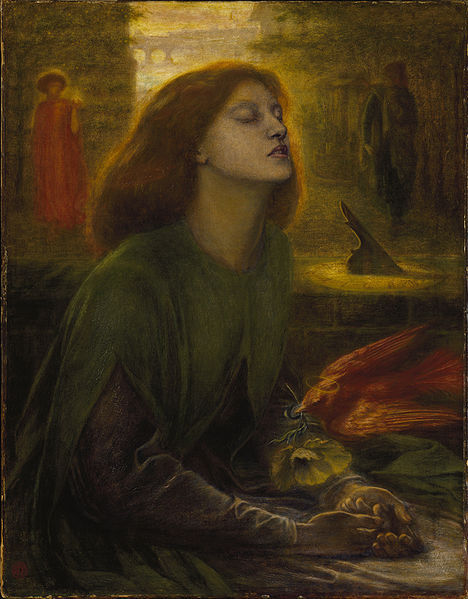
Dante Gabriel Rossetti, Beata Beatrix ([1864-]1872) [Elizabeth Siddal がモデル。ロセッティが1873年にモリスに送った手紙によれば、ダンテのベアトリーチェの死の表象というよりも「トランスないし不意の霊的変容によって象徴化して理想化した」もの "an ideal of the subject, symbolized by a trance or sudden spiritual transfiguration" これはテート・ギャラリー所蔵ヴァージョン。バーミンガム美術館のは花が赤い]
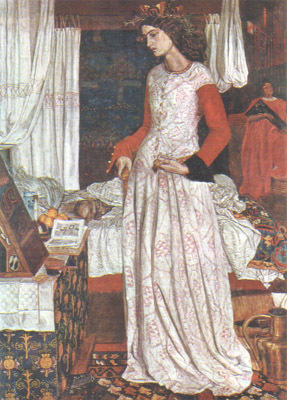
William Morris, La belle Iseult [Queen Guenevere] (1858)――モリス唯一の油絵は知り合ったころのジェーンをモデルにしたもの
ラスキンとは違って、ウィリアム・モリスとジェーンのあいだにはちゃんと子どもも生まれているのですけど――1861年と翌年に年子の姉妹が生まれていて、妹の May Morris (1861-1935) は社会主義者・工芸家になって活動します――、しだいに夫婦の仲は冷えていったらしい。
ロセッティは、1858年にやっぱり知り合っていたモデルの Fanny Cornforth (1835?-c1906) を家政婦として家に迎えて関係をもちながら、モリス夫妻と交流を続けて、ジェーンをモデルにした絵も描きつづけます。
.jpg)
Rossetti, The Blue Bower (1865) [Fanny Cornforth] image via Passiflora <http://www.passionflow.co.uk/art312141115.htm>
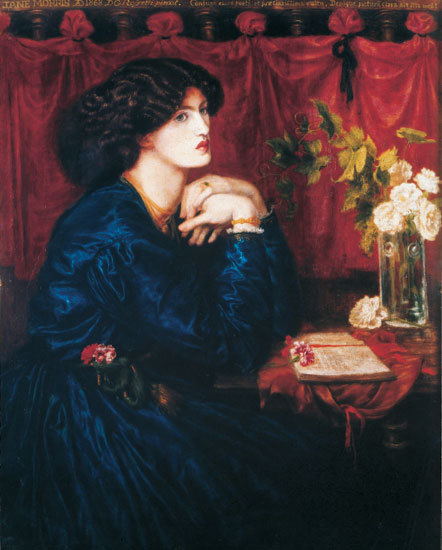
Rossetti, Jane Morris [The Blue Dress] (1868) image via Wikipedia
でペルセポネ、プロセルピーナといえば、あまりに有名なのが、最晩年まで反復される、ジェーン・モリスをモデルとした Proserpine の連作なのでした。1871年のパステル画にはじまり亡くなる1年前の1881年の油絵まで、執拗に。
で、不幸な結婚生活を送るジェーンをプロセルピーナに、冥王をウィリアム・モリスになぞらえる解釈みたいなのが自ずと行なわれてきたのですけど、絵が貼れなくなったので、別の記事につづきます。
/////////////////////////////////////////
"Chronology" The Arts and Crafts Home: A Design Source for Home Decoration 〔Mark Golding さん作成(あるいは from: Arts and Crafts by Anscombe and Gere)の年表 1819 [ラスキンの生年]-1919[バウハウスの創設]〕 <http://www.achome.co.uk/chronology/chronology.htm>
"The William Morris Internet Archive: Chronology" 〔Nick Salmon さん作成の年譜。marxists.org 内〕 <http://www.marxists.org/archive/morris/works/chrono.htm>
六粒の柘榴の種――母と娘のはなし(デーメテールとペルセポネ) "The Six Pomegranate Seeds" by Mary MacGregor (1910) [Marginalia 余白に]
1910年にメアリー・マグレガーという女性(たぶんスコットランド系のひと)が出版した『ギリシャの物語』という本にウォルター・クレインは19葉の扉絵と挿絵を描いていて、その第3章が "The Six Pomegranate Seeds" というタイトルで、ペルセポネの話を扱っていました (pp. 6-10)
Mary MacGregor. The Story of Greece: Told to Boys and Girls. [with Nineteen Plates in Colour by Walter Crane] London and Edinburgh: T. C. & E. C. Jack, 1910. xvi+356pp. (103 chapters) e-book @ openlibrary <http://openlibrary.org/books/OL7086918M/The_story_of_Greece>
子供向けということで、ジョイス君に捧げられているのですけど、英語もやさしいし、なかば写経的に書き留めておこうと思いました。6ページと7ページのあいだ、そして10ページと11ページのあいだに挿絵が入っています。全103章で300ページを超す本に19しか絵がないのですから、例外的な扱い、ということになるでしょうか。と思ったら、パンの挿絵で、これは前の第2章が "The Great God Pan" なのでした。
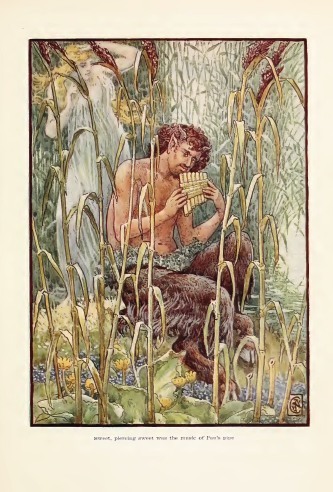
Sweet, piercing sweet was the music of Pan's pipe
THE SIX POMEGRANATE SEEDS
DEMETER, the goddess of the earth, was often to be seen in the fields in springtime. As the Greek peasants sowed their seed they caught glimpses of her long yellow hair while she moved now here, now there, among them. It almost seemed to these simple folk as though already the bare fields were golden with the glory of harvest, so bright shone the yellow hair of the goddess. Then they smiled hopefully one to the other, knowing well that Demeter would give them a bounteous reaping-time.
In the autumn she was in the fields again, the peasants even dreamed that they saw her stoop to bind the sheaves. Certainly she had been known to visit their barns when the harvest was safely garnered. And stranger still, it was whispered among the womenfolk that the great Earth-Mother had entered their homes, had stood close beside them as they baked bread to feed their hungry households.
It was in the beautiful island of Sicily, which lies in the Mediterranean Sea, that the goddess had her home. Here she dwelt with her daughter Persephone, whom she loved more dearly than words can tell.
Persephone was young and fair, so fair that she seemed as one of the spring flowers that leaped into life when her mother touched the earth with her gracious hands. Early as the dawn the maiden was in the fields with Demeter, to gather violets while the dew still lay upon them, to dance and sing with her playmates. At other times she would move gravely by the side of her mother to help her in her quiet labours.
All this time, Pluto, King of Hades, was living in his gloomy kingdom underground, longing for some fair maiden to share his throne. But there was not one who was willing to leave the glad light of the sun, no, not though Pluto offered her the most brilliant gems in his kingdom.
One day the dark king came up out of the shadows, riding in his chariot of gold, drawn by immortal horses. Swifter was their pace than that of any mortal steeds.
Persephone was in a meadow with her playfellows when the king drew near. The maiden stood knee-deep amid the meadow-grass, and, stooping, plucked the fragrant sweet flowers all around her hyacinth, lilies, roses, and pale violets.
Pluto saw the group of happy maidens, beautiful each one as a day in spring, but it was Persephone who charmed him more than any other.
'She shall be my queen and share my throne,' muttered the gloomy king to himself. Then, for he knew that to woo the maiden would be vain, Pluto seized Persephone in his arms, and bore her weeping to his chariot.
Swift as an arrow the immortal steeds sped from the meadow, where Persephone's playmates were left terrorstricken and dismayed.
On and on flew the chariot. Pluto was in haste to reach Hades ere Demeter should miss her daughter.
A river lay across his path, but of this the king recked naught, for his steeds would bear him across without so much as lessening their speed.
But as the chariot drew near, the waters began to rise as though driven by a tempest. Soon they were lashed to such fury that Pluto saw that it was vain to hope to cross to the other side. So he seized his sceptre, and in a passion he struck three times upon the ground. At once a great chasm opened in the earth, and down into the darkness plunged the horses.
A moment more and Pluto was in his own kingdom, Persephone by his side.
When the king seized the maiden in the meadow, and bore her to his chariot, she had cried aloud to Zeus, her father, to save her. But Zeus had made no sign, nor had any heard save Hecate, a mysterious goddess, whose face was half hidden by a veil.
None other heard, yet her piteous cry echoed through the hills and woods, until at length the faint echo reached the ear of Demeter.
A great pain plucked at the heart of the mother as she heard, and throwing the blue hood from off her shoulders, and loosening her long yellow hair, Demeter set forth, swift as a bird, to seek for Persephone until she found her.
To her own home first she hastened, for there, she thought, she might find some trace of the child she loved so well.
But the rooms were desolate as 'an empty bird's nest or an empty fold.'
The mother's eyes searched eagerly in every corner, but nothing met her gaze save the embroidery Persephone had been working, 'a gift against the return of her mother, with labour all to be in vain.' It lay as she had flung it down in careless mood, and over it crept a spider, spinning his delicate web across the maiden's unfinished work.
For nine days Demeter wandered up and down the earth, carrying blazing torches in her hands. Her sorrow was so great that she would neither eat nor drink, no, not even ambrosia, or a cup of sweet nectar, which are the meat and drink of the gods. Nor would she wash her face. On the tenth day Hecate came towards her, but she had only heard the voice of the maiden, and could not tell Demeter who had carried her away.
Onward sped the unhappy mother, sick at heart for hope unfulfilled, onward until she reached the sun. Here she learned that it was Pluto who had stolen her daughter, and carried her away to his gloomy kingdom.
Then in her despair Demeter left all her duties undone, and a terrible famine came upon the earth. 'The dry seed remained hidden in the soil; in vain the oxen drew the ploughshare through the furrows.'
As the days passed the misery of the people grew greater and greater, until faint and starving they came to Demeter, and besought her once again to bless the earth.
But sorrow had made the heart of the goddess hard, and she listened unmoved to the entreaties of the hungry folk, saying only that until her daughter was found she could not care for their griefs.
Long, weary days Demeter journeyed over land and sea to seek for Persephone, but at length she came back to Sicily.
One day as she walked along the bank of a river, the water gurgled gladly, and a little wave carried a girdle almost to her feet.
Demeter stooped to pick it up, and lo! it was the girdle that Persephone had worn on the day that she had been carried away. The maiden had flung it into the river as the chariot had plunged into the abyss, hoping that it might reach her mother. The girdle could not help Demeter to recover her daughter, yet how glad she was to have it, how safe she treasured it!
At length, broken-hearted indeed, Demeter went to Zeus to beg him to give her back her daughter. 'If she returns the people shall again have food and plenteous harvests,' she cried. And the god, touched with the grief of the mother and the sore distress of the people, promised that Persephone should come back to earth, if she had eaten no food while she had lived in the gloomy kingdom of Hades.
No words can tell the joy with which Demeter hastened to Hades. Here she found her daughter with no smile upon her sweet face, but only tears of desire for her mother and the dear light of the sun. But alas! that very day Persephone had eaten six pomegranate seeds. For every seed that she had eaten she was doomed to spend a month each year with Pluto. But for the other six months, year after year, mother and daughter would dwell together, and as they clung to one another they were joyous and content.
So for six glad months each year Demeter rejoiced, for her daughter was by her side, and ever it was spring and summer while Persephone dwelt on earth. But when the time came for her to return to Hades, Demeter grew ever cold and sad, and the earth too became weary and grey. It was autumn and winter in the world until Persephone returned once more.
-62954.jpg)
Demeter rejoiced for her daughter was by her side
[The Story of Greece Told to Boys and Girls by Mary MacGregor with nineteen plates in colour by Walter Crane. Published in 1910 by T.C. & E.C. Jack, Ltd. in London and Edinburgh]
ううむ。性的なアテコスリはまったく排除されていますねー。ヘルメスも出てきーへんし。ペルセポネはけっこうあとまで maiden と呼ばれてるし。





.jpg)